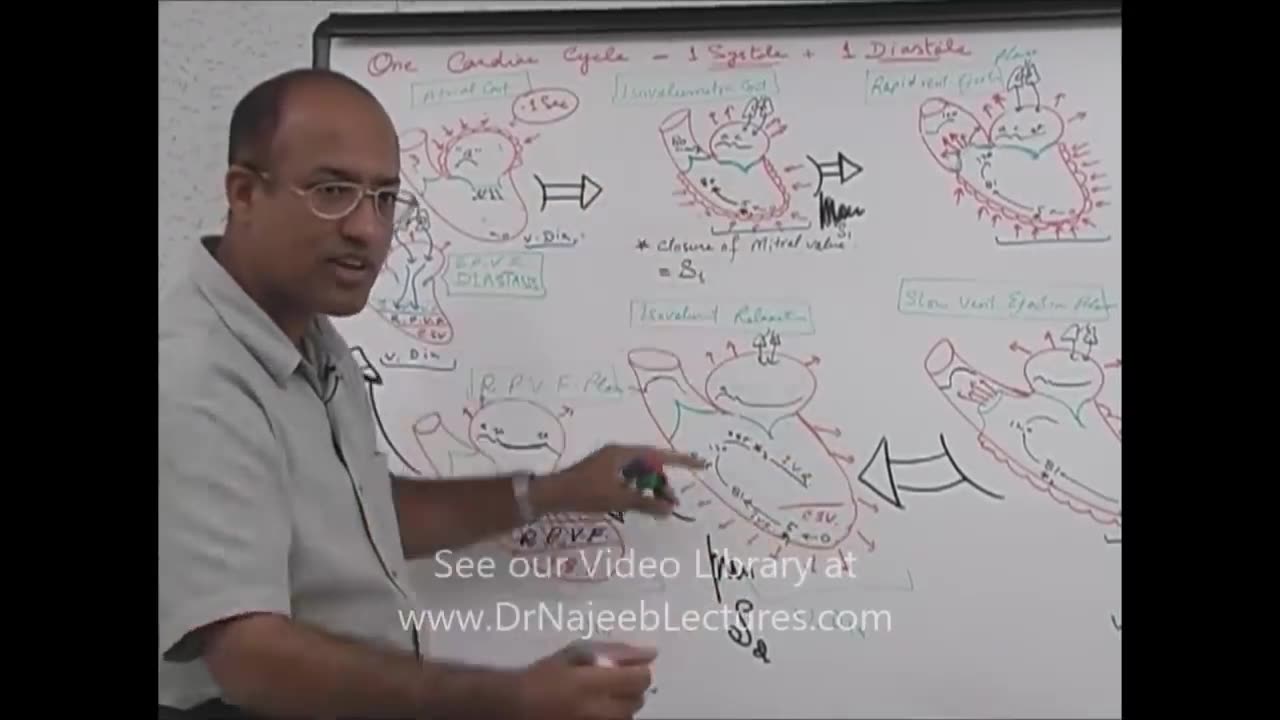Premium Only Content

Cardiac Cycle | Cardiology | Systole & Diastole | Cardiovascular
1. More than 800+ Medical Lectures.
2. Basic Medical Sciences & Clinical Medicine.
3. Mobile-friendly interface with android and iOS apps.
4. English subtitles and new videos every week.
5. Download option for offline video playback.
6. Fanatic customer support and that's 24/7.
7. Fast video playback option to learn faster.
8. Trusted by over 2M+ students in 190 countries.
---------------------------------------------------------------------------------------------------------------------------
The cardiac cycle is the performance of the human heart from the beginning of one heartbeat to the beginning of the next. It consists of two periods: one during which the heart muscle relaxes and refills with blood, called diastole, following a period of robust contraction and pumping of blood, dubbed systole. After emptying, the heart immediately relaxes and expands to receive another influx of blood returning from the lungs and other systems of the body, before again contracting to pump blood to the lungs and those systems. A normally performing heart must be fully expanded before it can efficiently pump again. Assuming a healthy heart and a typical rate of 70 to 75 beats per minute, each cardiac cycle, or heartbeat, takes about 0.8 seconds to complete the cycle.[2] There are two atrial and two ventricle chambers of the heart; they are paired as the left heart and the right heart—that is, the left atrium with the left ventricle, the right atrium with the right ventricle—and they work in concert to repeat the cardiac cycle continuously, (see cycle diagram at right margin). At the start of the cycle, during ventricular diastole–early, the heart relaxes and expands while receiving blood into both ventricles through both atria; then, near the end of ventricular diastole–late, the two atria begin to contract (atrial systole), and each atrium pumps blood into the ventricle below it.[3] During ventricular systole the ventricles are contracting and vigorously pulsing (or ejecting) two separated blood supplies from the heart—one to the lungs and one to all other body organs and systems—while the two atria are relaxed (atrial diastole). This precise coordination ensures that blood is efficiently collected and circulated throughout the body.[4]
00:42 Cardiac cycle definition
1:26 Events in left side of heart
1:26 Left atrium contraction
7:55 Ventricular contraction
10:44 First heart sound
12:53 Isovolumetric contraction
18:30 Rapid ventricular ejection
25:30 Slow ventricular ejection phase
29:34 Isovolumetric relaxation
34:50 Rapid passive ventricle filling phase
39:00 Slow passive ventricle filling/Diastases
42:00 Active atrial contraction
42:30 Durations of Systole and diastole
45:04 Heart sounds in different phases of cardiac cycle
51:46 Cardiac cycle in graphical fashion
51:46 Atrial contraction
54:00 Onset of ventricular contraction/S1
56:52 Rapid ejection phase
58:14 Slow ejection of ventricle
59:46 Isovolumetric relaxation/S2
01:01:17 Rapid passive ventricular filling and beginning of next cycle
01:04:19 Heart sounds in reference to Systole and diastole
01:07:02 Graphic representation of volume
01:08:19 Brief discussion on ECG
-
 LIVE
LIVE
Matt Kohrs
9 hours agoBreaking Market News, Markets Breakout & Live Trading $1M || The MK Show
1,472 watching -
 35:50
35:50
BonginoReport
4 hours agoMy Dad's Senate Hearing - Kids, Chaos, and Everything! (Ep.120) - 01/16/2025
24.3K50 -
 LIVE
LIVE
Vigilant News Network
14 hours agoBUSTED: O’Keefe Exposes Secret Pentagon Plot to Sabotage Trump’s Return | The Daily Dose
1,447 watching -
 LIVE
LIVE
2 MIKES LIVE
11 hours agoTHE MIKE SCHWARTZ SHOW with DR. MICHAEL J SCHWARTZ 01-16-2025
244 watching -
 43:10
43:10
PMG
11 hours agoHannah Faulkner and Jeff Younger | Father fights for his son!
6.62K1 -
 1:24:14
1:24:14
Game On!
14 hours ago $3.41 earnedTaylor Swift SHOCKS Chief fans! Does NOT want Travis Kelce to retire!
25.9K8 -
 4:27
4:27
Reforge Gaming
14 hours agoTHIS will not save Ubisoft.
42.4K4 -
 7:35
7:35
Tactical Advisor
1 day agoNEW Springfield Prodigy Compact (FIRST LOOK)
87K7 -
 16:45
16:45
IsaacButterfield
1 day ago $6.28 earnedWoke TikToks Are DESTROYING The World
37.1K33 -
 1:09:27
1:09:27
State of the Second Podcast
19 hours agoThis is Why We Don’t Trust Politicians (ft. @stones2ndsense)
31.2K4